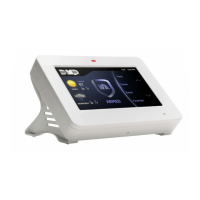
Do you have a question about the DMP Electronics XTLtouch and is the answer not in the manual?
| Category | Security System |
|---|---|
| Memory | 512MB RAM |
| Storage | 4GB Flash |
| Resolution | 800 x 480 pixels |
| Connectivity | Ethernet, Wi-Fi |
| Power Supply | 12V DC |
Action to take when a real alarm occurs, confirming it.
Action to take for a false alarm, cancelling it.
Overview of key elements like icons, weather, and interactive shield.
Icons indicating system status on the home screen.
Shows current and forecasted weather conditions.
LED indicating keypad power and system arming status.
Reader for disarming the system with a card or keyfob.
Touch interface for arming and disarming system.
Arrows and menu for system navigation.
Indicates system readiness for arming, shown by a check mark.
Displays event or trouble messages and affected zones.
Icon indicating low or disconnected battery.
Icon indicating the chime feature is active.
Icon indicating the system is not receiving AC power.
Icon indicating a connection to a Wi-Fi network.
Provides local weather conditions and temperature forecasts.
Logo area for security provider contact information.
Table explaining LED states for armed status and power.
Reader for disarming the system with a card or keyfob.
Touch interface for arming and disarming system options.
Details on Perimeter, Home, Sleep, Away, and All arming modes.
The screen area for displaying codes and messages.
Includes Select Areas, CMD, and Back Arrow buttons.
Used for menu navigation and saving input.
Used for navigating back or erasing characters.
Navigates functions/options; CMD shows more if >4.
Entering characters using number keys and select areas.
Entering characters via alpha/symbol modes on the keypad.
Table mapping number keys to character select areas.
Visual representations of keypad interfaces.
Keypad home screen options available when the system is armed.
Functions accessible from the armed home screen.
Steps to arm the system using exit time.
Steps to arm the system instantly without exit time.
Procedure for bypassing faulted zones before arming.
Three main times to disarm: during alarm, at home, upon entry.
Steps for responding to real or false alarms.
Steps to disarm the system when at home.
Steps to disarm the system when entering through an armed door.
Using navigation arrows or touch to scroll through menu options.
Overview of available options like Panic, Chime, Reset, Favorites.
Send panic report for Police, Emergency, or Fire.
Turn chime on/off for door/window alerts.
Reset smoke, flood, temp sensors after alarm.
Activate Z-Wave favorites (preset device combinations).
Allows leaving through an exit door without triggering alarm.
Adjust keypad brightness, tone, and volume.
Accesses the system user menu via the keypad.
Add, edit, delete user codes for system access.
Create and manage schedules for auto-arming/disarming and Z-Wave devices.
View up to 200 past system events.
Adjust Z-Wave thermostat settings (temp, mode).
Lock/unlock Z-Wave doors and garage doors.
Turn Z-Wave lights ON/OFF or DIM.
Steps to access the system's user menu via keypad.
Procedure to access the user menu using keypad commands.
Resets smoke, flood, temperature sensors after alarms.
Create and manage up to 25 Z-Wave devices per favorite.
Program Z-Wave devices: ADD, LIST, REMOVE, FAV, XFER, OPT.
Add, remove, or test Wi-Fi networks (WPS, LIST, MANUAL, TEST).
Bypass open zones before arming the system.
Monitor zones and chime feature functionality.
Test battery, alarm, and monitoring station communication.
Add, edit, and delete user codes with authority levels.
Create and manage schedules for auto-arming/disarming and Z-Wave devices.
Set or adjust the time and date on the keypad.
View up to 200 past system events.
Send a service request to the security provider.
Four-digit codes for system access via keypad or app.
Explains user number, code, name, and authority level.
Steps to add a user, set code, name, and authority (Master/Standard).
Procedure to remove an existing user code.
Procedure to modify an existing user code's details.
Control lights, locks, appliances, thermostats via Z-Wave.
Steps to add new Z-Wave devices to the system.
List and cycle through connected Z-Wave devices.
Steps to remove Z-Wave devices from the system.
Replace system Z-Wave data with info from another system.
Update communication path for Z-Wave devices.
Combine multiple Z-Wave devices for quick activation.
Methods to access and activate existing favorites.
Steps to create a new favorite and assign Z-Wave devices.
Modify favorite settings and associated Z-Wave devices.
Steps to activate a favorite from carousel or user menu.
Set recurring times for system arming/disarming and Z-Wave device control.
Create recurring schedules for arming/disarming.
Modify the closing time of an existing schedule.
Assign schedules to Z-Wave favorites for activation.
Schedule Z-Wave outputs to turn ON/OFF automatically.
Specify ON and OFF times for Z-Wave outputs.
Set output schedules based on sunrise/sunset with offsets.
Steps for preparing an emergency evacuation plan.